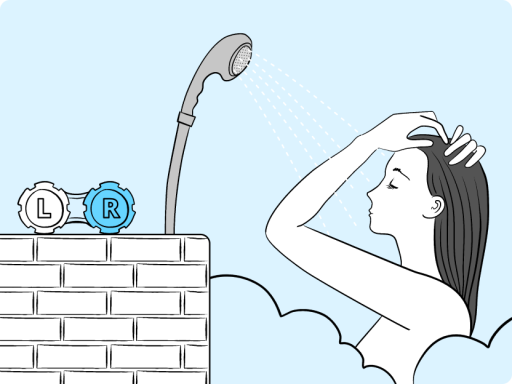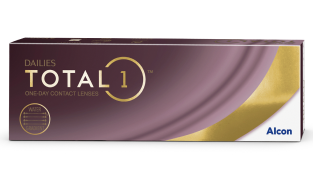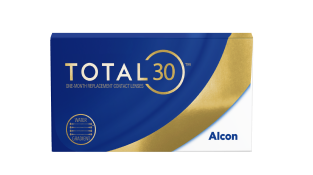Contact Lenses and Care
Can I Wear My Contact Lenses in the Shower?1
4 mins read
Water can damage a lens just as dramatically as a torn fingernail or bit of dirt. So here we expand upon the tricky relationship that contact lenses have with water—in this case under the shower.
Alongside sleeping and swimming in them, wearing lenses in the shower is one of the most common mistakes made by contact lens lovers. It’s so tempting just to leave them in—and most people have no idea that this is a no-no. But why?
The key point to make is that the jet of water pounding down at you from the shower head comes from your mains supply, which is connected to water traveling through the national network of pipes and pumping stations. This is wonderfully clean and safe to drink, but not to put in your eyes, especially not when wearing contact lenses. Water contains a range of detergent chemicals like chlorine, which are not designed to go in your eyes or lenses, plus bacteria and microbes looking for nice warm places in which to multiply.
Although the chances of picking up an infection from wearing lenses in the shower are lower than from doing so in a swimming pool, it makes sense to avoid both risks.
Your lenses are like sponges, so they love water. The problem is that bacteria love water too. Anyone who’s suffered from a case of conjunctivitis will understand why this is a problem. As with a range of similar eye infections, it’s both painful and upsetting.

Yes, the chances of this happening to you are small, but just as you wear a seat belt in the car to protect you in the unlikely event of a crash, it makes sense not to wear your contact lenses in the shower, keeping you safe in the equally unlikely event of a bug attack.
The other issue is that shower water can cause soft contact lenses to change shape, swell or get stuck on your eye. At best this is uncomfortable. At worst, it can scratch your cornea—with the scratch marks acting like a welcoming doorway for infection-causing germs.
The easy way to avoid any risk of such nastiness is to take a shower before putting in your lenses. You may end up associating everything in the shower with a soft-focus blur, but your eyes will thank you, as you protect both your eyesight and eye health. If you then dry yourself using a standard towel, it’s a good idea to have a smaller or alternative lint-free microfiber towel kept on hand, for drying your fingers and face. This will ensure no stray fibrous strands or specks of dirt come between you and perfectly clean, dry fingertips, when putting in your lenses.

Equally, it makes sense to take out your lenses in the evening before you shower, if this is part of your night-time routine. This is particularly sensible for those who like to switch to glasses after a day of contact lens wear, immediately before retiring to read in bed, or to give their eyes an evening break. The key point is that if you shower either side of contact lens wear, you will never have to worry about any unpleasant consequences.
If you realise you’ve stepped into the shower with your lenses in, close your eyes and step out of the shower. Remove your lenses and either put them in fresh contact lens solution (if you’re a monthly replacement contact lens wearer) or prepare new daily disposable contact lenses for when you’ve finished showering.
If you decide not to follow this advice and deliberately continue wearing lenses whilst showering, at the very least keep your eyes shut when under the shower head, especially when applying shampoo or soap. If you direct a power shower into your eyes, you shouldn’t be surprised if you wash a lens right out of your eye.
Also keep your eyes shut if you wear lenses in the bath or a hot tub. This is important whenever you splash water anywhere near your face or disappear beneath the waterline in search of your rubber duck.
Unsurprisingly, the same guidance applies to your daily face wash too. The tap water in your sink contains the same hidden armies of microbes as the shower.
So please - no splashing water from any source into your eyes when wearing lenses. The chances of an inflammation are small, but since it’s totally preventable, why take the risk? If you do accidentally leave your lenses in while you shower, and you notice any eye irritation afterwards, contact your optician for help and information on what to do next.


DAILIES TOTAL1™
The first and only daily disposable lenses with nearly 100% water at the surface2, so nothing touches the eye but a gentle cushion of moisture.†3


TOTAL30™
The first and only monthly replacement Water Gradient contact lenses so comfortable they feel like nothing, even at day 30.‡4


AOSEPT™ PLUS with HydraGlyde™
Cleans 99. 9% of bacteria§5,6
REFERENCES
†Based on 90.4% of wearers agreeing with the statement, "while wearing my lenses, I sometimes forget I have them on".
‡Based on more than 70% of wearers agreed with the statements ‘These lenses were so comfortable I didn’t feel anything’ and ‘I did not have to think about my contact lenses today’, n=66.
§Based on laboratory studies on selected organisms.
1. About Contact Lenses. CDC. Website. https://www.cdc.gov/contact-lenses/about/index.html. Updated May 27, 2025. Accessed September 2025.
2. Thekveli S, Qui Y, Kapoor Y, et al. Structure-property relationship with delefilcon A lenses. Contact Lens Anterior Eye. 2012; 35 [Suppl 1]:e14.
3. Perez-Gomez I, Giles T. European survey of contact lens wearers and eye care professionals on satisfaction with a new water gradient daily disposable contact lens. Clin Optom. 2014;6:17-23.
4. In a clinical study wherein patients (n=66) used AOSEPT® solution for nightly cleaning, disinfecting, and storing; Alcon data on file, 2021. Study CLY935-C013 p.4.
5. Gabriel MM, et al. Biocidal Efficacy of a Hydrogen Peroxide Lens Care Solution Incorporating a Novel Wetting Agent. Eye Contact Lens. 2019 May;45(3):164-170.
6. Nichols, J. et al. The Case for Using Hydrogen Peroxide Contact Lens Care Solutions: A Review. Eye & Contact Lens. 45 (2)
Data on file references available at AUS: 1800 224 153; Auckland NZ: 0800 101 106.
For contact lenses and contact lens care: Consult your eye care professional for wear, care, precautions, warnings, contraindications and adverse effects.
ALWAYS READ THE LABEL AND FOLLOW THE DIRECTIONS FOR USE.
All content on this website is for informational purposes only, always talk to your health professional regarding your eye health or medical conditions.